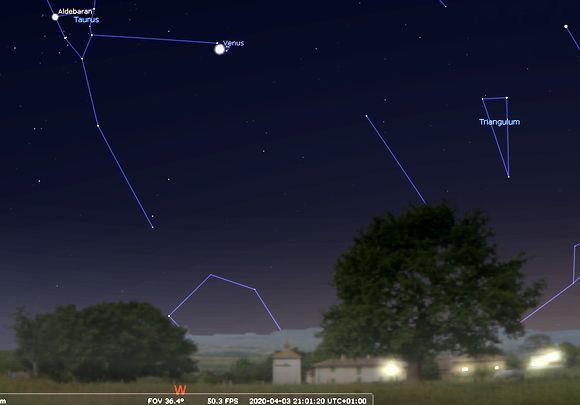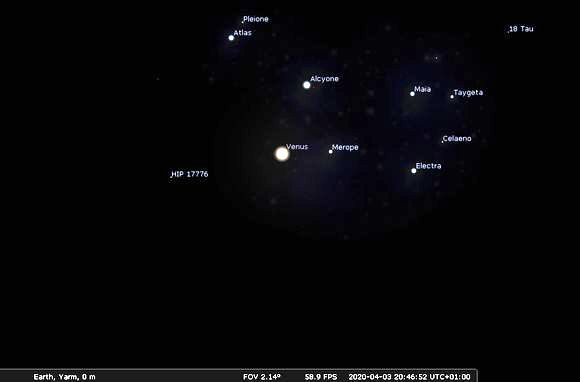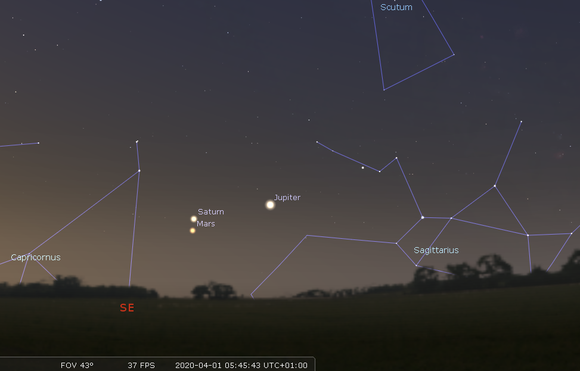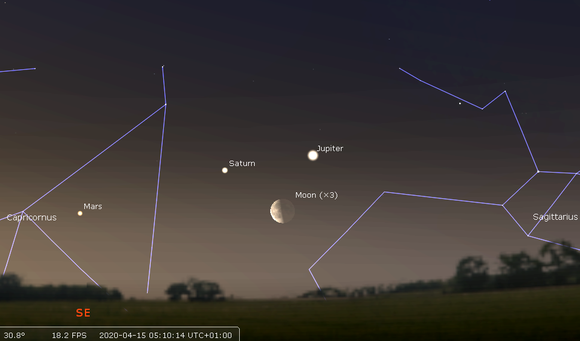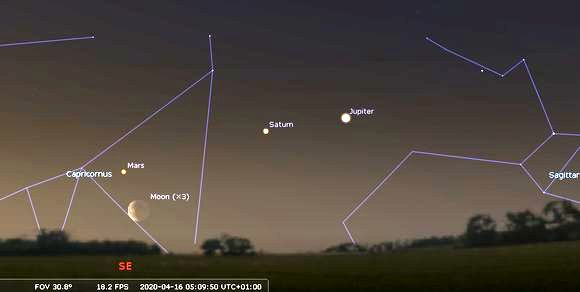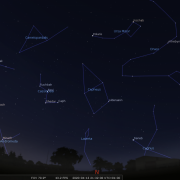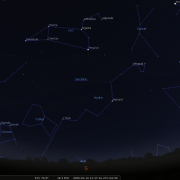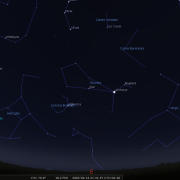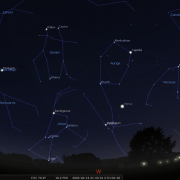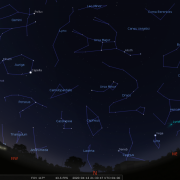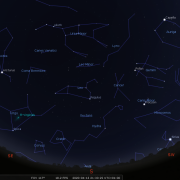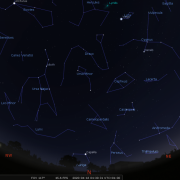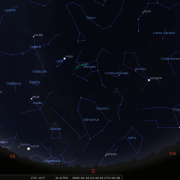In this month's Sky Notes:
Planetary Skylights
Evening Planets
Venus rules in the evening sky, whilst Mars, Jupiter and Saturn vie for attention in the dawn sky.

 Venus will continue to dominate the pre-midnight evening sky during April, a
Venus will continue to dominate the pre-midnight evening sky during April, a
brilliant beacon hard not to miss! At the start of the month Venus is involved in a spectacular conjunction with the lovely star cluster known as the Pleiades or Seven Sisters.
Observe over the first couple of evenings of April as Venus edges ever closer to the cluster, passing through the eastern fringes of the group on April 3rd. The view will be best appreciated through binoculars or a short focal length telescope at low power, which will also reveal the phase of Venus, which changes gradually to a crescent by the end of April.
Bear in mind that Venus is just a few tens of millions miles away, whereas the Pleiades members reside around 410 light years! If you have one, use a screw on colour filter (yellow or green) to reduce the glare from Venus and more comfortably distinguish the phase and perhaps even some subtle darker marking in the cloud duvet.
Venus reaches greatest brilliancy on April 28th – a brilliant - 4.7 in magnitude, bright enough to cast a shadow. A crescent Moon lies lower left of Venus on the 27th.


 Jupiter, Mars and Saturn are all located low in the east – southeast dawn sky. Of these, Jupiter is by far the most conspicuous to the eye, visible from 05:00h until dawn.
Jupiter, Mars and Saturn are all located low in the east – southeast dawn sky. Of these, Jupiter is by far the most conspicuous to the eye, visible from 05:00h until dawn.
To the left of Jupiter, resides pearly white Saturn, relatively prominent, but only a quarter the brilliance of Jupiter. Mars lies a little further to the east and is the least conspicuous of the three planets. The ‘Red planet’ has a distinct amber hue, but as yet is disappointing when viewed telescopically, the diminutive disk still too distant to reveal detail.
Even though far more distant than Mars, Jupiter and Saturn, the two largest planets in the solar system, have much to scrutinise in the eyepiece. Jupiter exhibits the cloud belts, great red spot and Galilean moons, whilst Saturn’s ring system is still orientated to us. A word of caution, the low altitude of these planets will make observations somewhat reliant on those moments of ‘good seeing’, so patience at the eyepiece is required. The waning Moon passes below Jupiter and Saturn on the 15th and Mars the following morning.
Meteors

This month’s most prolific meteor shower; the Lyrids, last from about April 16th until April 25th, peaking over the last hour of the 21st into the early morning hours of the 22nd this year.
The Lyrids are associated with comet Thatcher (C/186 G1) a periodic comet taking approximately 415 years to orbit the Sun. The comet last visited us in 1861.
Each April Earth plows through debris left behind by the comet giving rise to the shooting stars we observe. Lyrids are typically as bright as a second magnitude star, but as with most meteor showers there is always the chance of witnessing something a great deal brighter. These so called ‘Lyrid fireballs’ can exceed Venus in brilliance (which currently dominates the evening sky). Such shooting stars can momentarily cast a shadow, sometimes leaving behind smoking debris trails that can linger for over a minute.
Remember though that the vast majority of meteors are no bigger in size than instant coffee granules and even the really bright ones only marble sized!
The radiant of the shower lies not far from the lovely brilliant steely blue star Vega in Lyra - the Harp, which during the early morning hours is rising into the north east aspect. Observing at such a time, expect to spot 10-20 meteors per hour on the 22nd. Do not however look in the direction of Lyra, but instead view at least two hand spans away from it. The Moon is new on the 23rd – so prospects for the shower are very favourable.
A number of lesser meteor showers occur during April. The Virginids and alpha Scorpiids each have zenith hourly rates (ZHR) of half a dozen, or so, equating to ‘normal’ sporadic meteor activity levels. The Virginids peak over the night of April 7/8th, which coincide with the Full moon and will be drowned out. The Scorpiids peak on the 27th and will fare better but you will have to observe in the early morning hours.
|
Looking North
Mid-April - 21:30h |
Looking South |
|
Looking East
Mid-April - 21:30h |
Looking West
Mid-April - 21:30h |
|
Northern Aspect
Mid-April - 21:30h |
Southern Aspect
Mid-April - 21:30h |
|
Looking North (Early)
Mid-April - 04:30h |
Looking South (Early)
Mid-April - 04:30h |
Additional Image Credits:
- Planets and Comets where not otherwise mentioned: NASA
- Sky Charts: Stellarium Software
- Log in to post comments

